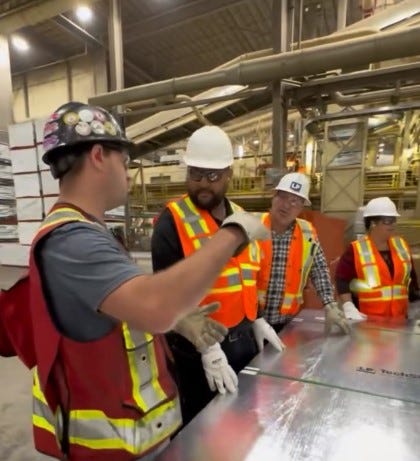Forest Minister responsive to city’s concerns, says Mayor
Forest Minister Ravi Parmar spent most of last week in northeastern British Columbia, visiting communities from Fort Nelson to Dawson Creek, meeting with municipal leaders, industry members, wildfire fighters and First Nations and listening to their concerns.
Ministers coming to the North and spending any length of time here is unusual, said Mayor Lilia Hansen during Parmar’s visit to the region last week. They normally just fly in, do a photo op and fly out again, she said, adding that it’s nice to see a minister spending quality time in the region.
Hansen first spoke to Parmar back in January at the BC Natural Resources Forum, when the closure of Fort St. John’s Canfor mill was still raw and asked him when he was coming north.
“I think it’s important for me, as representative of my community that my community is seen and heard and recognized in the good times and when we’re feeling the pinch,” Hansen said. “I was feeling crushed that we had lost over 220 jobs, and I wanted [us] to be seen, heard and recognized.”
Hansen said she glad that Parmar took the time to come to the North and spend quality time in the communities, learning about the needs of the forest industry in the region.
“It’s really important to me that Minister Parmar is here in the area, to actually be present and to see what we’re talking about, especially when we’re talking about fibre, when we’re talking about the distance between mills and areas, and why we feel it’s so important for investment in rail and transportation.”
Part of Parmar’s visit included a two-and-a-half-hour meeting with Fort St. John’s mayor and city council, in which the minister seemed to be responsive to the city’s concerns. Parmar was very approachable, listened respectively and acknowledged all their concerns, Hansen said.
One of the concerns was the need for upgrades to the CN Rail lines in the area. While as a private company, CN needs to see a return on any investments it makes in that regard, Hansen maintains that transportation upgrades are needed to encourage business investment and grow the economy in the region.
For example, Fort Nelson is four hours away and has wood that the remaining mill in Fort St. John needs.
“How do we make it affordable? I want to see everybody win, companies make money, and they report to their shareholders, but they also employ my neighbours,” she said.
“We need to have that investment in transportation before we’re going to see any more manufacturing jobs, or potential coming because it’s one of the first things an investor is going to look at.”
Hansen says Parmar seems to be wanting to learn as much about his portfolio as possible, which she says is not an easy portfolio to have, especially with mills closing around the province. There are only three mills remaining north of Prince George – the Louisiana-Pacific operations in Fort St. John and Dawson Creek, and one in Chetwynd. Once there were mills in almost every community north of the Pine Pass.
Other concerns that council addressed with Parmar were the uncertainty of permits, which Hansen said was a major contributing factor for Canfor’s decision to shut down its Fort St. John mill in December 2024.
“Most businesses, you give them a timeline, this is when you submit it, this when you can expect to have feedback, this is when you’ll get a response on that. We’ve definitely gone two to three years for some of these, so we broached that,” Hansen said.
Doing a better job of streamlining applications, with legwork in advance and creating partnerships with First Nations, before the permit application is submitted will speed up the time it takes to have the permits reviewed.
“Most of us, whether it’s municipalities or industry, I think we all agree on some common concerns, like transportation and the costs of doing business,” Hansen said.
“It’s all about affordability, and how we can get the wood to the mills.”
Some of that wood includes salvaging trees from the recent wildfires in the region.
“There are permits being issued for that, and many of those have a First Nations partnership,” Hansen said.
“We also talked about stumpage, and it’s my understanding that the provincial government is looking at a lower rate for stumpage on the burnt wood for salvage.”
Another concern was the large swaths of downed trees, that because of the remoteness of the area, are difficult to access and salvage.
“How do we access that affordably in order to do something with them?” Hansen said. “There’s always that concern about having that potential for stoking another fire.”
During his visit, Parmar expressed his concern over the potential for more wildfires, particularly because the years of drought northeastern BC has experienced. He estimates that by the end of 2025, approximately 30 percent of the forested land base in the region will have been impacted by fires, since 2023.
“This region is the economic engine of our province. It’s home to forestry, oil and gas, and many other natural resource industries; it’s also a region that has faced uncertainty, mill closures, job losses and shifting global markets,” Parmar said.
“The conversations I’m having on the ground help shape how we respond to wildfires, as well as the economic transition, and the land use and long-term sustainability discussions on the ground.”




